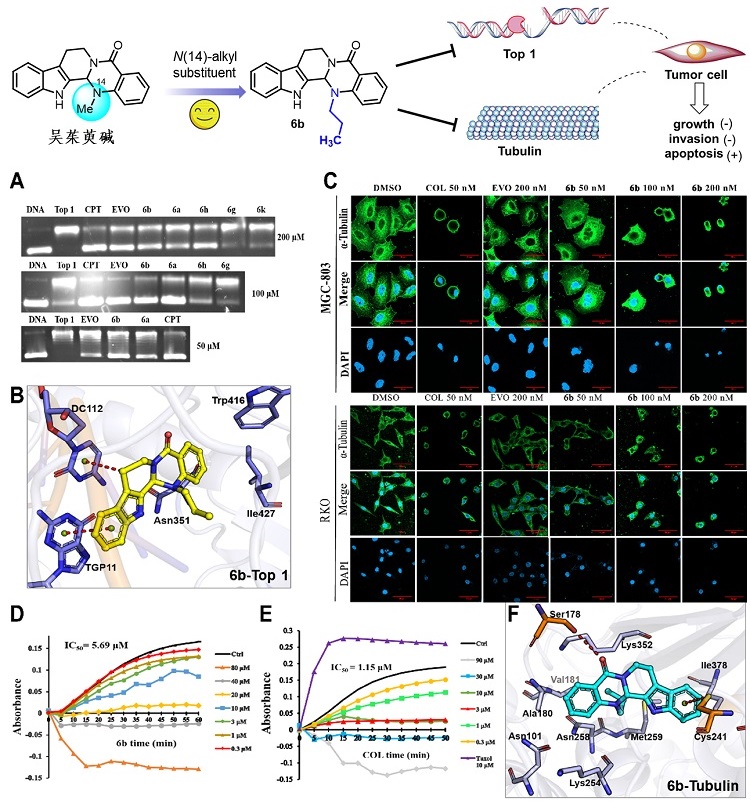
EJMC team of Professor Linsheng Zhuo and Zhen Wang of Hengyang School of Medicine of the University of South China: the first Evodiamine lead drug with dual target against gastrointestinal tumors
In the current environment of poor eating habits and food safety, gastrointestinal tumors are a major threat to the health of human beings, especially young people. Natural products and their structural modifiers are rich resources and scientific basis for the discovery of original new chemical entities and the research and development of anti-gastrointestinal tumor drugs. Evodia is a natural traditional Chinese herbal medicine in China, which has been widely used for thousands of years to treat symptoms such as gastrointestinal diseases, amenorrhea, headache and postpartum hemorrhage. Evodiamine is an alkaloid with a new quinazoline and carroline backbone isolated from evodia fruit, with a broad spectrum of antitumor activity, and is expected to succeed camptothecin and doxorubicin as the next generation of natural alkaloids as blockbuster chemotherapy drugs, highly sought after in academia and the pharmaceutical community.
Recently, Dr. Zhuo Linsheng of Professor Wang Zhen's team of Hengyang Medical College of the University of South China designed and synthesized a series of N(14)-alkyl-substituted evodiamine derivatives on the basis of the previous research work of the research group, and finally found that N(14)-propyl substituted evodiamine analogue 6b (Figure 1). The compound has no effect on MGC-803 (IC50 = 0.09 μM) and RKO (IC50 = 0.2 μM) cell lines show low nanomolar inhibitory activity and effectively induce apoptosis, retard cell cycle arrest in the G2/M phase, and inhibit migration and invasion of MGC-803 and RKO cell lines in a dose-dependent manner. Further antitumor mechanistic studies showed that 6b significantly inhibits topoisomerase 1 (Top 1, 50.58% inhibition at 3 μM) and tubulin(Tubulin, I50 = 5.69 μM) polymerization. It can be seen that compound 6b represents a promising double Top 1/Tubulin inhibitor lead structure. The relevant results were recently published in the European Journal of Medicinal Chemistry (IF:7.09), with Professor Wang Zhen and Dr. Zhuo Linsheng of the University of South China as corresponding authors, and doctoral students Deng Jiedan and Long Lin Co-first author. The results of this study provide a major scientific basis for the innovative development of anti-gastrointestinal tumor drug research and development.

Figure 1. Biological activity results of compound 6b and its docking analysis with Top 1 and Tubulin's mode of action
Natural product-based drug discovery is a popular paradigm for expanding the chemical space and confirming new molecular entities that can improve human disease. In the current strategic opportunity period for the revitalization and development of Chinese medicine, Professor Wang Zhen's team took the new synthesis methodology as the starting point to thicken the medical theory of the traditional Chinese medicine evodia, and studied evodiamine Systematic structural modification and deep exploration of its extensive medicinal value has been carried out. Focusing on the bottleneck problem of poor metabolic stability of evodiamine, the team proposed the "metabolic soft spot obstruction" strategy, which introduced functionalized fragments of different structural types on its 14-bit N atom, reducing the electron cloud density of N atoms or increasing the steric hindrance around N atoms, hindering the occurrence of oxidative metabolic reactions from the atomic level. In addition, the team proposed for the first time a new method for the synthesis of evodiamine and its derivatives based on the construction strategy of "three bonds and two rings". This method not only greatly enriches its "chemical space" at the N(14) position, but also enables kilogram-scale preparation (laying the foundation for a large supply of drugs for clinical research, Figure 2).

图2. 吴茱萸碱衍生物库的构建及其工艺路线
The team constructed a library of more than 300 small molecule evodiamine derivatives, and discovered a number of anti-tumor drug candidates with clinical development value and preclinical candidate NHW011007 (IND, Figure 3) through systematic structure-activity research. The innovative achievements in this direction have published 9 SCI papers in international first-class journals such as Journal of Medicinal Chemistry, and applied for 6 Chinese invention patents (1 authorized). At present, the team's progress in medicinal chemistry based on evodiamine and the further development of candidate compounds are accelerating. The structural formula of this series of compounds has established complete patent protection, and the team welcomes the negotiation and transformation of results.

Figure 3. Evodiamine derivatives with clinical development prospects and leading structural properties
Name: Eric Yuan
Mobile:86-18427358861
Tel:86-18427358861
Whatsapp:+86 18427358861
Email:yihekeji@chembuying.com
Add: